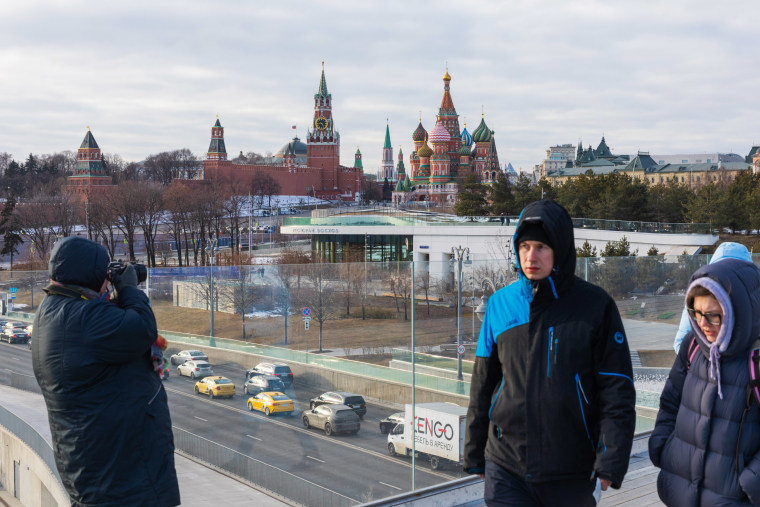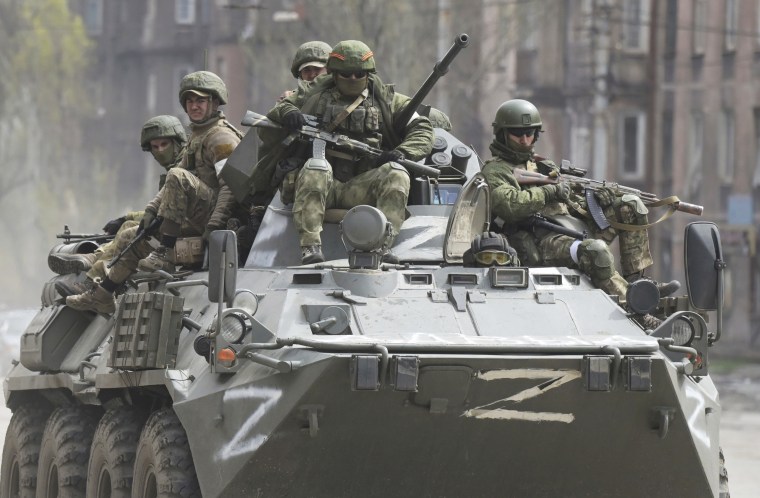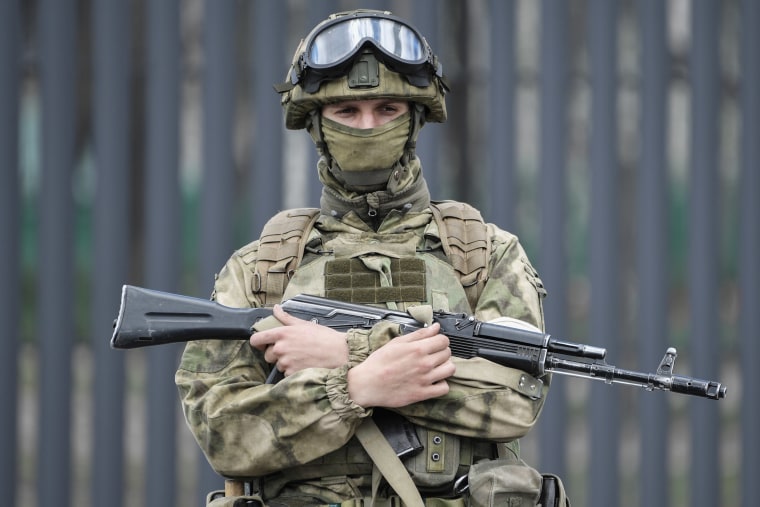The war in Ukraine is widening.
With Russia’s advance stalled due to fierce local resistance and Western support, analysts say both sides appear ready to dig in for a protracted conflict that is showing increasing signs of spilling beyond the battlefield.
From warning of nuclear confrontation to stoking energy crises and perhaps even eyeing up fresh territories to invade, Moscow has ramped up its threats this week — but so has the West: The United States and its allies are readying huge new shipments of heavy weapons and military equipment to help Ukrainian troops on the ground, while voicing more ambitious goals for the conflict.
The Kremlin and the West appear to have embraced a broader clash over Ukraine, one that extends far beyond the grounds of the Donbas and could define Europe’s landscape well into the future while increasingly resembling its Cold War past.
U.S. officials say President Joe Biden’s request to Congress to provide $33 billion to Ukraine, which includes $20 billion for military equipment and assistance, would allow Kyiv and its allies to withstand months more Russian aggression.
The request followed remarks by Defense Secretary Lloyd J. Austin this week that initially caused some disquiet among European allies. Speaking to reporters after a visit to Kyiv, Austin said the U.S. wanted to see Russia “weakened to the extent that it can’t do the kinds of things that it has done in invading Ukraine.”
Dan Hamilton, senior nonresident fellow at the Brookings Institute, told NBC News that several countries, notably France, experienced “discomfort” over Austin’s remarks for appearing to swell war aims beyond the immediate defense of an ally and into a strategic wearing down of a nuclear-armed adversary.
“They said ‘that’s not our approach to this,’” Hamilton said. “But it’s certainly Poland’s approach, the Baltic states’ approach, Ukraine’s approach to it."
Hamilton said that the U.S. funding package was significant not only for its scope but also in its aim to drive a wedge between Moscow and other states.
Russia’s decision, meanwhile, to cut off gas supply to Poland and Bulgaria was viewed in the West as a major escalation.
William Alberque, director of strategy, technology and arms control at the International Institute for Strategic Studies, a London-based think tank, said the move showed how, for Russia, “all other nonmilitary instruments of power are now in play.”
“Whether it’s trying to call in favors from [Hungarian President Victor] Orban’s government, trying to help Marine Le Pen win the election in France or the direct use of the energy weapon in Poland and Bulgaria to try to get ahead of sanctions,” he said, “Vladimir Putin is reading the tea leaves and sees that the West is trying to cut off oil and gas, and if he moves first he might be able to divide us.”
Rhetoric from the Kremlin has become increasingly bellicose in recent weeks, with Foreign Minister Sergei Lavrov warning that Western arms shipments to Ukraine were a “legitimate target” — raising the prospect of a direct conflict between Russia and NATO members.

Lavrov cautioned Ukraine’s allies against sparking the next world war and insisted that the prospect of Russia deploying nuclear weapons “should not be underestimated.” This latest broadside came just days after Moscow said it had successfully tested its new nuclear-capable intercontinental ballistic missile.
Alberque said Russia under Putin had a long history of similar threats: in 1999 after the NATO bombing of Yugoslavia, during the 2008 Georgia War, and most recently in 2015, when Denmark tried to join NATO’s missile shield.
While stressing that it was unlikely Russia would wish to enter into a nuclear conflict, Alberque said that the mere threat of one holds genuine strategic purpose for Putin, well beyond Ukraine.
“Russia believes quite rightly that threats often work to compel their foes towards inhibition and limit their decision-making,” he said. “Putin has learned over time that high-level threats really intimidate people.”
Rose Gottemoeller, former NATO deputy secretary general and a former U.S. arms control negotiator who served under both the Clinton and Obama administrations, said that the threat of a Russian nuclear conflict with the West had grown steadily under Putin.
“Nuclear saber rattling can have implications for the strength of your nuclear deterrent, unless heaven forbid, you follow through on the threats,” she said.
“Nobody wants to see any use of nuclear weapons in this conflict. So in that regard, it is a dangerous moment.”
Nor are nuclear weapons the only menace that Moscow has wielded in the Ukraine context in recent days. Military commander Rustam Minnekaev last week appeared to suggest that Russia was targeting an invasion of Transnistria, an unrecognized breakaway republic of Moldova on Ukraine’s southwestern flank. At least three explosions were reported in the territory this week.
Tatsiana Kulakevic, affiliate professor at the University of South Florida’s Institute on Russia, said that the logistics of Russia expanding its already stretched supply line several hundred kilometers further east would prove challenging, but Putin may consider it a risk worth taking.
“If Russia makes it to Transnistria overland, that is when we might see a Russian move against Moldova,” Kulakevic said. “Moldova is on the list of former Soviet Republics that Putin says shouldn’t exist.”
Indeed, Hamilton said that the West should be under no illusion that Putin was evaluating the possibility of widening the war.
Russia’s intended rapid conquest of Ukrainian territory and removal of the government in Kyiv did not materialize, chiefly due to fierce local resistance by a well-drilled defensive army.

“But in Moldova — a much weaker country, very fragile, poor, with a separatist entity on its territory and no real military capacity whatsoever — I could easily see a decapitation strategy there happening quickly,” said Hamilton.
Whether or not threats to use nuclear weapons or to invade new territories are realistic, they have proliferated just as Russia’s incursion into Ukraine has stagnated. After being forced to retreat from the outskirts of Kyiv at the start of April, Russian control is now largely confined to eastern and southern regions, notably the Donbas. This is the Black Sea region where Putin has claimed victory but where Ukrainian troops are still resisting in the ruined port city of Mariupol.
In addition to redoubled U.S. support, European countries — notably Germany — appear to have overcome their initial reluctance to provide Ukraine with lethal military equipment, even after Lavrov’s warning, and the type of arms being sent to the front line have evolved in step with the war’s changing dynamic.
“We’re in a different phase of the war now that we were in late February to early April, which was Russia thinking it was going to win the war really quickly and so the West sent just whatever it could whenever it could,” Alberque said.

“This phase now, where it is about command and control and massive artillery, Ukraine simply needs different equipment.”
It is now just under two weeks until Russia celebrates Victory Day — the commemoration of the Soviet Union’s defeat of Nazi Germany — a public holiday traditionally accompanied by a military parade in Moscow’s Red Square.
But a speedy resolution seems unlikely for the conflict, which has already cost tens of thousands of Ukrainian and Russian lives and is likely to leave lingering animosity across the entire region.
Hamilton said that after shooting to international stardom for his response to the invasion, Ukrainian President Volodymyr Zelenskyy was unlikely to accept any settlement that would allow Russia to keep the territory it has seized. Nor is Putin likely to accept any demand to return it.
He said the best-case scenario might involve a cease-fire and a “protracted line of control” with troops from both countries massed on both sides for years.
“We are facing persistent confrontation with Russia and a sporadically — if not consistently — violent space in eastern Europe,” Hamilton said.